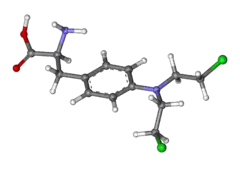Melphalan
Melphalan, sold under the trade name Alkeran among others, is a chemotherapy medication used to treat multiple myeloma, ovarian cancer, melanoma, and AL amyloidosis.[1] It is used by mouth or by injection into a vein.[1]
 | |
 | |
| Clinical data | |
|---|---|
| Trade names | Alkeran, Evomela, Phelinun, others |
| Other names | (2S)-2-amino-3-{4-[bis(2-chloroethyl)amino]phenyl}propanoic acid |
| AHFS/Drugs.com | Monograph |
| MedlinePlus | a682220 |
| License data | |
| Routes of administration | By mouth (tablets), intravenous |
| ATC code | |
| Legal status | |
| Legal status |
|
| Pharmacokinetic data | |
| Bioavailability | 25–89% (By mouth) |
| Metabolism | Hydrolysis to inactive metabolites |
| Elimination half-life | 1.5 ± 0.8 hours |
| Excretion | Kidney (IV: 5.8–21.3%) |
| Identifiers | |
| |
| CAS Number | |
| PubChem CID | |
| IUPHAR/BPS | |
| DrugBank | |
| ChemSpider | |
| UNII | |
| KEGG | |
| ChEBI | |
| ChEMBL | |
| CompTox Dashboard (EPA) | |
| ECHA InfoCard | 100.005.207 |
| Chemical and physical data | |
| Formula | C13H18Cl2N2O2 |
| Molar mass | 305.20 g·mol−1 |
| 3D model (JSmol) | |
| |
| |
| (verify) | |
Common side effects include nausea and bone marrow suppression.[1] Other severe side effects may include anaphylaxis and the development of other cancers.[1] Use during pregnancy may result in harm to the baby.[2] Melphalan belongs to the class of nitrogen mustard alkylating agents.[1] It works by interfering with the creation of DNA and RNA.[1]
Melphalan was approved for medical use in the United States in 1964.[1] It is on the World Health Organization's List of Essential Medicines.[3] It is available as a generic medication.[4]
Medical uses
It is used to treat multiple myeloma,[5] ovarian cancer, AL amyloidosis, and occasionally malignant melanoma.
The agent was first investigated as a possible drug for use in melanoma, it was not found to be effective.
In 2016, it was approved in the U.S. for:
- use as a high-dose conditioning treatment prior to hematopoietic progenitor (stem) cell transplantation in multiple myeloma (MM) patients
- the palliative treatment of MM patients for whom oral therapy is not appropriate[6]
Melphalan is currently being used to treat ocular retinoblastoma, a pediatric solid tumor. This is accomplished via transarterial catheter based slow pulsed infusion into the ophthalmic artery.[7]
Side effects
Common side effects include:[1]
- Nausea
- Bone marrow suppression, including
- Decreased white blood cell count causing increased risk of infection
- Decreased platelet count causing increased risk of bleeding
Less common side effects include:
- Severe allergic reactions[1]
- Pulmonary fibrosis (scarring of lung tissue) including fatal outcomes (usually only with prolonged use)
- Hair loss
- Interstitial pneumonitis
- Rash
- Itching
- Irreversible bone marrow failure due to melphalan not being withdrawn early enough
- Cardiac arrest
Mechanism of action
Melphalan chemically alters the DNA nucleotide guanine through alkylation, and causes linkages between strands of DNA. This chemical alteration inhibits DNA synthesis and RNA synthesis, functions necessary for cells to survive. These changes cause cytotoxicity in both dividing and non-dividing tumor cells.[8]
Synthesis
Another amino acid-like drug is the antineoplastic agent melphalan. Tumor cells spend less time in resting phases than normal cells so at any given time, they are more likely to be metabolically active than most normal host cells. The rationale behind incorporating an alkylating function in a molecule resembling a primary cellular metabolite was to get a greater safety margin by fooling tumor cells into taking up the toxin preferentially.

4-Nitro-L-phenylalanine (1) was converted to its phthalimide by heating with phthalic anhydride, and this was converted to its ethyl ester (2). Catalytic hydrogenation produced the corresponding aniline. Heating in acid with oxirane, followed by treatment with phosphorus oxychloride provided the bischloride, and removal of the protecting groups by heating in hydrochloric acid gave melphalan (3).
Society and culture
Legal status
On 17 September 2020, the Committee for Medicinal Products for Human Use (CHMP) of the European Medicines Agency (EMA) adopted a positive opinion, recommending the granting of a marketing authorization for melphalan.[12] The applicant for this medicinal product is ADIENNE S.r.l. S.U.[12]
References
- "Melphalan Monograph for Professionals". Drugs.com. American Society of Health-System Pharmacists. Retrieved 9 October 2019.
- "Melphalan Use During Pregnancy". Drugs.com. Retrieved 9 October 2019.
- World Health Organization (2019). World Health Organization model list of essential medicines: 21st list 2019. Geneva: World Health Organization. hdl:10665/325771. WHO/MVP/EMP/IAU/2019.06. License: CC BY-NC-SA 3.0 IGO.
- British national formulary : BNF 76 (76 ed.). Pharmaceutical Press. 2018. pp. 873–874. ISBN 9780857113382.
- Facon T, Mary JY, Hulin C, et al. (October 2007). "Melphalan and prednisone plus thalidomide versus melphalan and prednisone alone or reduced-intensity autologous stem cell transplantation in elderly patients with multiple myeloma (IFM 99-06): a randomised trial". Lancet. 370 (9594): 1209–18. doi:10.1016/S0140-6736(07)61537-2. PMID 17920916. S2CID 10450108.
- "Evomela (melphalan) for Injection, for Intravenous Use. Full Prescribing Information". Spectrum Pharmaceuticals, Inc. Irvine, CA 92618. Retrieved 17 March 2016.
- Gobin YP, Dunkel IJ, Marr BP, et al. (June 2011). "Intra-arterial chemotherapy for the management of retinoblastoma: four-year experience". Arch Ophthalmol. 129 (6): 732–7. doi:10.1001/archophthalmol.2011.5. PMID 21320950.
- "Melphalan". National Cancer Institute. Retrieved 4 August 2014.
- Bergel, F.; Stock, J. A. (1954). "Cyto-active amino-acid and peptide derivatives. Part I. Substituted phenylalanines". Journal of the Chemical Society (Resumed): 2409. doi:10.1039/JR9540002409.
- Bergel, F.; Burnop, V. C. E.; Stock, J. A. (1955). "Cyto-active amino-acids and peptides. Part II. Resolution of para-substituted phenylalanines and synthesis of p-di-(2-chloroethyl)amino-DL-phenyl[?-14C]alanine". Journal of the Chemical Society (Resumed): 1223–1230. doi:10.1039/JR9550001223.
- Larionov LF, Khokhlov AS, Shkodinskaja EN, Vasina OS, Troosheikina VI, Novikova MA (1955). "Studies on the anti-tumour activity of p-di-(2-chloroethyl) aminophenylalanine (sarcolysine)". Lancet. 266 (6882): 169–71. doi:10.1016/S0140-6736(55)92736-7. PMID 13243678.
- "Phelinun: Pending EC decision". European Medicines Agency (EMA). 18 September 2020. Retrieved 21 September 2020. Text was copied from this source which is © European Medicines Agency. Reproduction is authorized provided the source is acknowledged.
External links
- "Melphalan". Drug Information Portal. U.S. National Library of Medicine.
- MSDS
